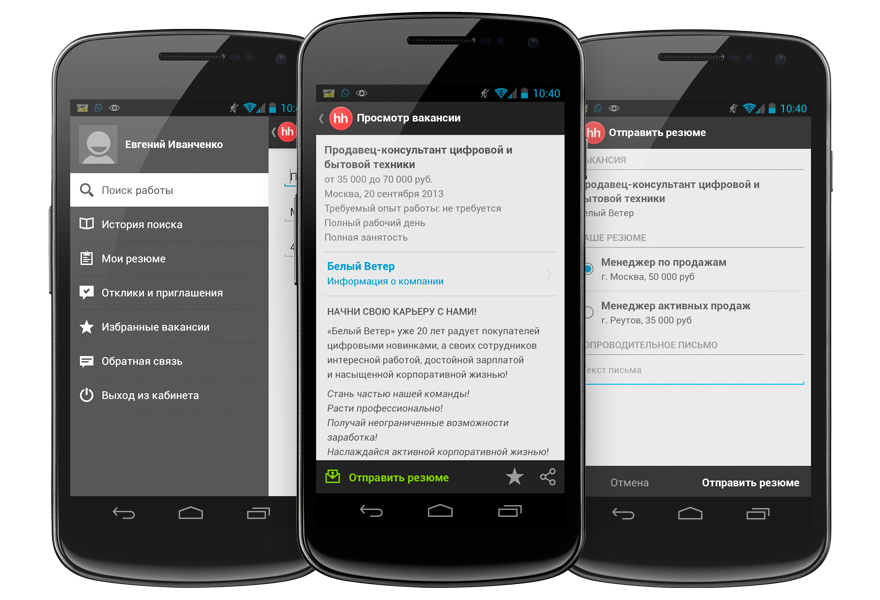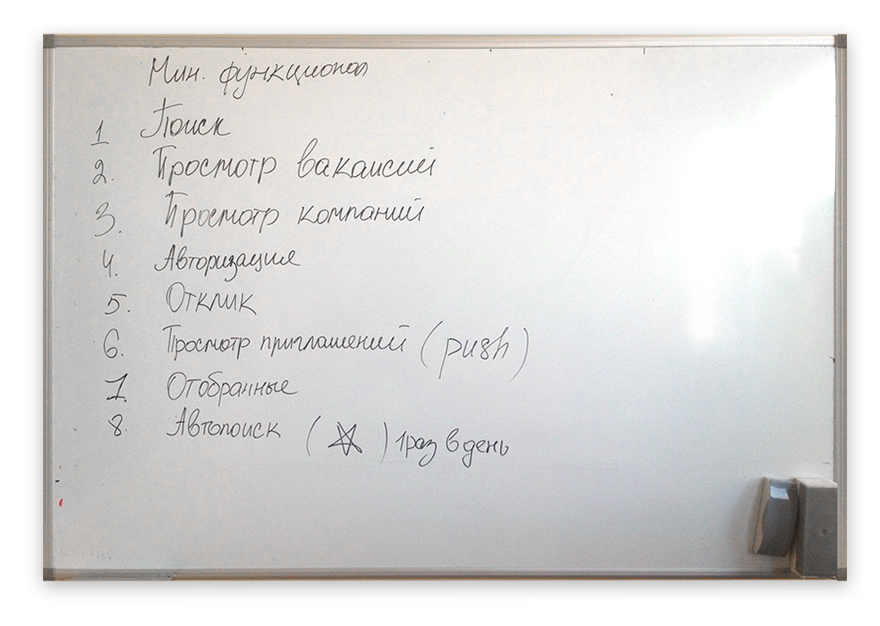HeadHunter on Android: finally!
We recently released an Android app. The first version has the basic functionality - now it is just convenient to look for a job in it, responding to the vacancies you like, but in the next releases the possibilities will expand. Above all, HeadHunter finally has an application with popular features, which we will now develop. It is available for installation on Google Play.
In this article, I would like to share with you our application development history.

In February of this year, hh.ru mobile traffic accounted for about 5.5% of the total, and in August it grew to 7.8%. In absolute terms, this means that about one and a half million people came to us from this or that mobile device. The share of gadgets on Android is from 30 to 40%. With such growth rates, by the beginning of the next year every tenth user of hh.ru will be “mobile”. This means that he will need a convenient and fast interface that allows him to do everything on the mobile device that he used to do on a regular website.
Last year we already released apps for iOS and Windows Phone. They were developed by external contractors, and the Android version was already made by our own team of four people (designer, developer, tester and manager), which we formed to continue the development of mobile applications for all popular platforms. Now it is one of the priority areas of work in the company.
')
When we were just starting to develop an Android application, the team working on the mobile direction within the company did not exist yet, it was only to be created. Therefore, we have assembled an initiative group and prepared the first “roadmap”.
Strategically, this plan has changed little so far, and now we continue to adhere to it, abandoning only auto searches for the first public release.

The team recruitment stage was not as fast as we wanted. In particular, at that time we did not have an interface specialist in the team. Therefore, it was decided to use the experience of flexible development methods in order to begin to receive intermediate results with still limited human resources. We began to formulate requirements for the application interface, practically, from scratch, using the modification of the Wizard of Oz practice to build the interface layout. In spite of the fact that we already had developments in applications, we wanted to at least check them for relevance, and preferably, to improve them.
The work was constructed as follows: a hand-drawn interface prototype was prepared. He was shown to the test participants, observing their reaction and expectations when the interface was changed. During the experiment, only the subject spoke, voicing his actions or expectations. If the next interface screen did not meet his expectations, then we drew or redraw it on the go. As a result, we received a prototype interface that has already passed the first user testing for suitability and is ready for setting a work assignment for the designer and developer.

I must say that the designer in the team appeared later than the developer, so we started working on the functionality and development on the requirements of paper prototypes. At first, the application looked like this:

We stopped at a step when the limit of transmitted meaning was reached with the help of simple graphic means. Basic requirements have been clarified. With the inclusion of the work of the designer work went more fun, he continued to elaborate the interface:

Prior to the beginning of the public alpha testing, we carried out a check of the interface in a paper version on real users. This is a variant of the Wizard of Oz, but with more elaborated layouts. I must say that “paper testing” is not a very convenient option for working out a mobile interface, because with ready-made images you want more interactivity than games with paperwork. However, this stage allowed us to test part of the hypotheses. For example, at first we wanted to greatly reduce the number of search parameters (search fields), but in the end, thanks to testing, we left the possibility of an advanced search.

When the first more or less stable version was ready, it needed to be tested in the field. To do this, we used the opportunities of Google Play to make alpha releases and distribute them through closed groups on Google+. By collecting even a small group for alpha testing, we received valuable feedback. We have already implemented most of the testers' wishes.
As a result, we got a good basic application with which you can:

On the day of the final version, we have already begun work on the following versions, which will add the following functions in the near future:
In addition, each of the next version will certainly contain small new features and improvements, because everything is in the details.
We also hope for an early strengthening of our team - this year a separate set for mobile development was made at HeadHunter’s programmer’s school .
UPD: You can install the application on Google Play:


In this article, I would like to share with you our application development history.

Why do we need applications and who makes them
In February of this year, hh.ru mobile traffic accounted for about 5.5% of the total, and in August it grew to 7.8%. In absolute terms, this means that about one and a half million people came to us from this or that mobile device. The share of gadgets on Android is from 30 to 40%. With such growth rates, by the beginning of the next year every tenth user of hh.ru will be “mobile”. This means that he will need a convenient and fast interface that allows him to do everything on the mobile device that he used to do on a regular website.
Last year we already released apps for iOS and Windows Phone. They were developed by external contractors, and the Android version was already made by our own team of four people (designer, developer, tester and manager), which we formed to continue the development of mobile applications for all popular platforms. Now it is one of the priority areas of work in the company.
')
Process of creation
When we were just starting to develop an Android application, the team working on the mobile direction within the company did not exist yet, it was only to be created. Therefore, we have assembled an initiative group and prepared the first “roadmap”.
- The minimum amount of a viable product (MVP - Minimal Viable Product) which includes functions that allow you to complete a full job search cycle. These include searching and viewing vacancies, viewing companies, responding to vacancies, viewing responses and invitations, push-notifications of invitations, adding vacancies to favorites, auto searches.
- The objectives of the product. Until the end of the year is the release of MVP.
- Risks. They were of two types: internal resource and external in the form of negative evaluations. Globally, there were practically no risks, since we are making a free application of the most popular job search service in Russia, and it will be in demand.
Strategically, this plan has changed little so far, and now we continue to adhere to it, abandoning only auto searches for the first public release.

The team recruitment stage was not as fast as we wanted. In particular, at that time we did not have an interface specialist in the team. Therefore, it was decided to use the experience of flexible development methods in order to begin to receive intermediate results with still limited human resources. We began to formulate requirements for the application interface, practically, from scratch, using the modification of the Wizard of Oz practice to build the interface layout. In spite of the fact that we already had developments in applications, we wanted to at least check them for relevance, and preferably, to improve them.
The work was constructed as follows: a hand-drawn interface prototype was prepared. He was shown to the test participants, observing their reaction and expectations when the interface was changed. During the experiment, only the subject spoke, voicing his actions or expectations. If the next interface screen did not meet his expectations, then we drew or redraw it on the go. As a result, we received a prototype interface that has already passed the first user testing for suitability and is ready for setting a work assignment for the designer and developer.

I must say that the designer in the team appeared later than the developer, so we started working on the functionality and development on the requirements of paper prototypes. At first, the application looked like this:

We stopped at a step when the limit of transmitted meaning was reached with the help of simple graphic means. Basic requirements have been clarified. With the inclusion of the work of the designer work went more fun, he continued to elaborate the interface:

Prior to the beginning of the public alpha testing, we carried out a check of the interface in a paper version on real users. This is a variant of the Wizard of Oz, but with more elaborated layouts. I must say that “paper testing” is not a very convenient option for working out a mobile interface, because with ready-made images you want more interactivity than games with paperwork. However, this stage allowed us to test part of the hypotheses. For example, at first we wanted to greatly reduce the number of search parameters (search fields), but in the end, thanks to testing, we left the possibility of an advanced search.

When the first more or less stable version was ready, it needed to be tested in the field. To do this, we used the opportunities of Google Play to make alpha releases and distribute them through closed groups on Google+. By collecting even a small group for alpha testing, we received valuable feedback. We have already implemented most of the testers' wishes.
Result
As a result, we got a good basic application with which you can:
- pick up interesting vacancies;
- send vacancy responses using your resume created on hh.ru;
- add vacancies to the "favorites" to respond to them later;
- Receive push notifications of invitations for an interview from employers;
- view a list of your resumes;
- view responses, invitations and their status.

Development plans
On the day of the final version, we have already begun work on the following versions, which will add the following functions in the near future:
- resume editing. We are still skeptical that a good resume can be created on the phone from scratch, simply because typing large text on the phone is an occupation for an amateur. In addition, it is important for employers to have a well-filled resume, and the telephone does not facilitate thorough filling. But it is quite possible to correct the existing, this is a fact;
- subscription to the search results for vacancies with the necessary parameters;
- work with data in offline mode;
- view vacancies on the map.
In addition, each of the next version will certainly contain small new features and improvements, because everything is in the details.
We also hope for an early strengthening of our team - this year a separate set for mobile development was made at HeadHunter’s programmer’s school .
UPD: You can install the application on Google Play:


Source: https://habr.com/ru/post/196568/
All Articles